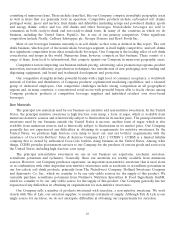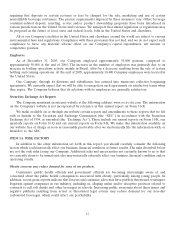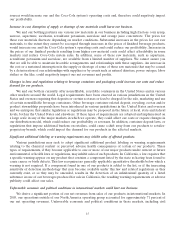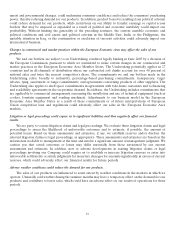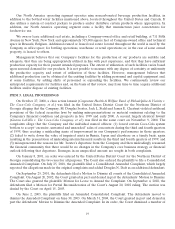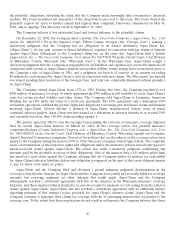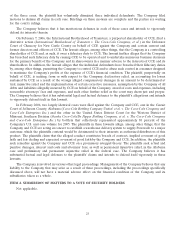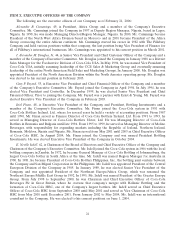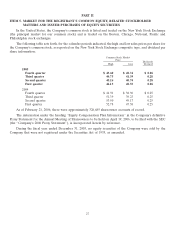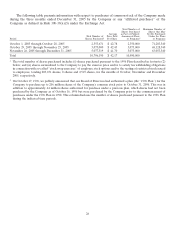Coca Cola 2005 Annual Report Download - page 21
Download and view the complete annual report
Please find page 21 of the 2005 Coca Cola annual report below. You can navigate through the pages in the report by either clicking on the pages listed below, or by using the keyword search tool below to find specific information within the annual report.Our North America operating segment operates nine noncarbonated beverage production facilities, in
addition to the bottled water facilities mentioned above, located throughout the United States and Canada. It
also utilizes a system of contract packers to produce and/or distribute certain products where appropriate. In
addition, our North America operating segment owns a facility that manufactures juice concentrates for
foodservice use.
We own or lease additional real estate, including a Company-owned office and retail building, at 711 Fifth
Avenue in New York, New York and approximately 315,000 square feet of Company-owned office and technical
space in Brussels, Belgium. Additional owned or leased real estate located throughout the world is used by the
Company as office space; for bottling operations, warehouse or retail operations; or, in the case of some owned
property, is leased to others.
Management believes that our Company’s facilities for the production of our products are suitable and
adequate, that they are being appropriately utilized in line with past experience, and that they have sufficient
production capacity for their present intended purposes. The extent of utilization of such facilities varies based
upon seasonal demand for our products. It is not possible to measure with any degree of certainty or uniformity
the productive capacity and extent of utilization of these facilities. However, management believes that
additional production can be obtained at the existing facilities by adding personnel and capital equipment and,
at some facilities, by adding shifts of personnel or expanding the facilities. We continuously review our
anticipated requirements for facilities and, on the basis of that review, may from time to time acquire additional
facilities and/or dispose of existing facilities.
ITEM 3. LEGAL PROCEEDINGS
On October 27, 2000, a class action lawsuit (Carpenters Health & Welfare Fund of Philadelphia & Vicinity v.
The Coca-Cola Company, et al.) was filed in the United States District Court for the Northern District of
Georgia alleging that the Company, M. Douglas Ivester, Jack L. Stahl and James E. Chestnut violated antifraud
provisions of the federal securities laws by making misrepresentations or material omissions relating to the
Company’s financial condition and prospects in late 1999 and early 2000. A second, largely identical lawsuit
(Gaetan LaValla v. The Coca-Cola Company, et al.) was filed in the same court on November 9, 2000. The
complaints allege that the Company and the individual named officers: (1) forced certain Coca-Cola system
bottlers to accept ‘‘excessive, unwanted and unneeded’’ sales of concentrate during the third and fourth quarters
of 1999, thus creating a misleading sense of improvement in our Company’s performance in those quarters;
(2) failed to write down the value of impaired assets in Russia, Japan and elsewhere on a timely basis, again
resulting in the presentation of misleading interim financial results in the third and fourth quarters of 1999; and
(3) misrepresented the reasons for Mr. Ivester’s departure from the Company and then misleadingly reassured
the financial community that there would be no changes in the Company’s core business strategy or financial
outlook following that departure. Damages in an unspecified amount are sought in both complaints.
On January 8, 2001, an order was entered by the United States District Court for the Northern District of
Georgia consolidating the two cases for all purposes. The Court also ordered the plaintiffs to file a Consolidated
Amended Complaint. On July 25, 2001, the plaintiffs filed a Consolidated Amended Complaint, which largely
repeated the allegations made in the original complaints and added Douglas N. Daft as an additional defendant.
On September 25, 2001, the defendants filed a Motion to Dismiss all counts of the Consolidated Amended
Complaint. On August 20, 2002, the Court granted in part and denied in part the defendants’ Motion to Dismiss.
The Court also granted the plaintiffs’ Motion for Leave to Amend the Complaint. On September 4, 2002, the
defendants filed a Motion for Partial Reconsideration of the Court’s August 20, 2002 ruling. The motion was
denied by the Court on April 15, 2003.
On June 2, 2003, the plaintiffs filed an Amended Consolidated Complaint. The defendants moved to
dismiss the Amended Complaint on June 30, 2003. On March 31, 2004, the Court granted in part and denied in
part the defendants’ Motion to Dismiss the Amended Complaint. In its order, the Court dismissed a number of
19



